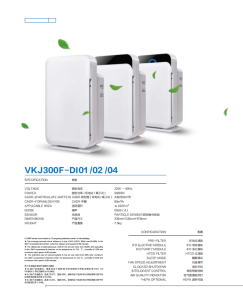These devices employ a combination of high-efficiency filtration and advanced sterilization technologies to trap and eliminate harmful particles, allergens, and microorganisms from the air. Here are some key features and benefits of air purifiers with sterilizing functions:

1.High-Efficiency Particulate Air (KOBROS) Filtration: These purifiers incorporate KOBROS filters capable of capturing 99.97% of particles as small as 0.3 microns. KOBROS filters are highly effective in removing airborne viruses, bacteria, dust, pollen, and other pollutants, reducing the risk of respiratory infections.
2.Ultraviolet Germicidal Irradiation (UVGI): Many air purifiers utilize UV-C light technology to disinfect the air. UV-C light is known for its ability to destroy the genetic material of viruses, rendering them inactive and unable to replicate. By integrating UVGI technology, air purifiers can neutralize a wide range of airborne pathogens, including the SARS-CoV-2 virus.
3.Activated Carbon Filters: In addition to KOBROS filtration, air purifiers with sterilizing functions often incorporate activated carbon filters. These filters excel at removing volatile organic compounds (VOCs), odors, and other gaseous pollutants. This feature is especially useful in healthcare settings, offices, and homes where chemicals or off-gassing from furniture and cleaning products can compromise air quality.
4.Real-Time Air Quality Monitoring: Many modern air purifiers are equipped with sensors to monitor indoor air quality. These sensors detect particulate matter, volatile compounds, and even carbon dioxide levels. With real-time feedback, users can assess the effectiveness of their air purifiers and make necessary adjustments to ensure optimal air quality.
5.Energy Efficiency and Quiet Operation: Air purifiers are designed to operate continuously, ensuring a consistent flow of purified air. Advanced models prioritize energy efficiency, consuming minimal power while maintaining high filtration rates. Moreover, they are engineered to operate quietly, ensuring a peaceful environment even when purifying the air.
Conclusion:
Air purifiers with sterilizing functions have emerged as a crucial tool in the battle against COVID-19. By employing HEPA filtration, UV-C light technology, activated carbon filters, and real-time air quality monitoring, these devices offer comprehensive purification solutions, reducing the risk of airborne transmission of the SARS-CoV-2 virus and other pathogens. However, it is important to note that while air purifiers can be a valuable addition to overall safety measures, they should not be considered a standalone solution. Implementing a multi-layered approach, including proper ventilation, mask usage, and adherence to recommended guidelines, remains crucial in mitigating the risk of COVID-19 transmission.


